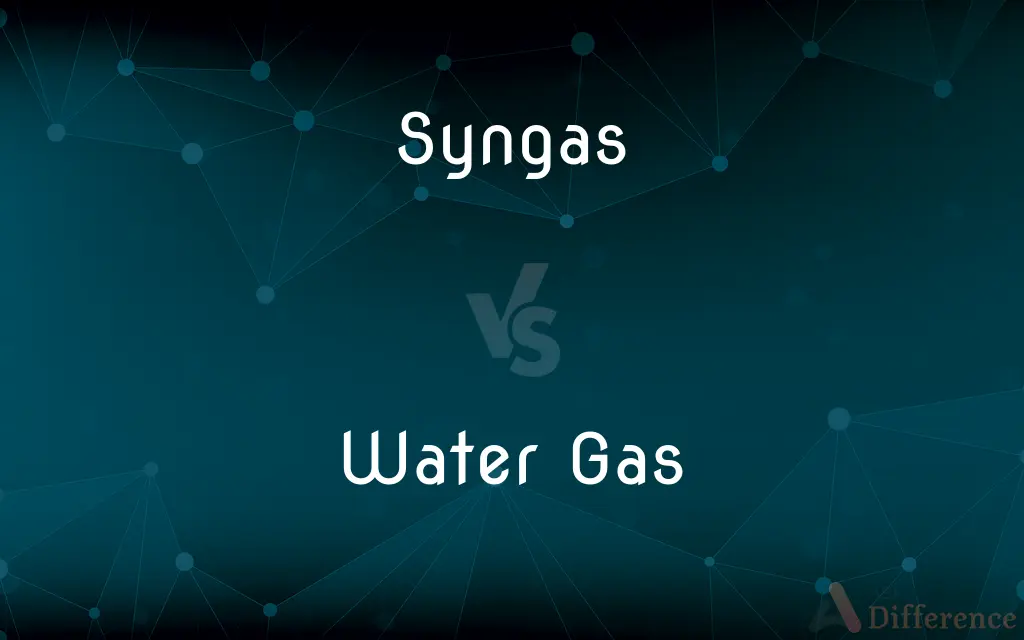Syngas vs. Water Gas — What's the Difference?
By Tayyaba Rehman — Published on January 17, 2024
Syngas is a fuel gas mixture of hydrogen, carbon monoxide, and often carbon dioxide, whereas water gas is a specific type of syngas made by passing steam over hot coal.

Difference Between Syngas and Water Gas
Table of Contents
ADVERTISEMENT
Key Differences
Composition and Production: Syngas is a versatile mixture of hydrogen and carbon monoxide, produced from a variety of processes including gasification of coal, biomass, and waste. Water gas is a subtype of syngas specifically produced by passing steam over hot coal, predominantly containing hydrogen and carbon monoxide.
Uses and Applications: Syngas is used for power generation, as a feedstock for producing chemicals, and in the synthesis of liquid fuels. Water gas, due to its composition, is used in synthesis processes and as a reducing agent in metallurgy.
Energy Efficiency and Environment: The production of syngas can be tailored for higher energy efficiency and lower environmental impact. Water gas production is less energy-efficient and has a higher carbon footprint.
Flexibility and Feedstock: Syngas production is flexible, utilizing various feedstocks like coal, biomass, and waste. Water gas is specifically made from coal, limiting its feedstock flexibility.
Historical and Modern Relevance: Syngas is a key element in modern gasification and chemical synthesis technologies. Water gas played a significant role in the development of early gas lighting and heating.
ADVERTISEMENT
Comparison Chart
Composition
Hydrogen, carbon monoxide, sometimes CO2
Mainly hydrogen and carbon monoxide
Production Process
Gasification of coal, biomass, waste
Produced by passing steam over hot coal
Primary Uses
Power generation, chemical feedstock
Synthesis processes, metallurgy
Environmental Impact
Can be produced with lower carbon footprint
Typically higher carbon footprint
Feedstock Flexibility
Diverse, including biomass and waste
Limited to coal
Compare with Definitions
Syngas
Chemical Feedstock: A key input for chemical synthesis.
Syngas is essential in producing methanol and other chemicals.
Water Gas
Coal Gasification Product: A gas produced from coal.
Water gas was historically used for street lighting.
Syngas
Fuel Gas Mixture: A gas mixture used as fuel.
Syngas is increasingly used in power plants for electricity generation.
Water Gas
Early Gas Fuel: Used before the widespread availability of natural gas.
Water gas was once a primary fuel for cooking and heating.
Syngas
Gasification Product: Produced through gasification of various materials.
Biomass gasification produces syngas as a byproduct.
Water Gas
Metallurgy Use: Utilized in metal processing.
Water gas serves as a reducing agent in steel manufacturing.
Syngas
Hydrogen Source: A source of hydrogen for various applications.
Syngas is used in the production of hydrogen for fuel cells.
Water Gas
Hydrogen and CO Mixture: Contains hydrogen and carbon monoxide.
Water gas is used in industrial processes as a reducing agent.
Syngas
Energy Carrier: A medium for storing and transporting energy.
Syngas is being explored as a way to store renewable energy.
Water Gas
Steam and Coal Reaction: Produced by reacting steam with coal.
The production of water gas involves passing steam over hot coal.
Common Curiosities
What is water gas?
A type of syngas produced from coal and steam.
What are the primary uses of syngas?
In power generation and chemical synthesis.
What is syngas?
A gas mixture used as fuel and chemical feedstock.
What are the main components of water gas?
Hydrogen and carbon monoxide.
Can syngas be produced from renewable resources?
Yes, from biomass and waste.
Is water gas still widely used?
Its use has declined with the availability of natural gas.
What was the historical significance of water gas?
It was important for early gas lighting and heating.
How does water gas production impact the environment?
It generally has a higher carbon footprint.
How is syngas produced?
Through gasification of coal, biomass, or waste.
Is syngas environmentally friendly?
It can be, depending on the feedstock and production method.
Are there any risks associated with syngas?
Yes, it is flammable and requires careful handling.
Was water gas used in homes?
Yes, for cooking and heating in the past.
Can syngas be used as a liquid fuel?
Yes, it can be converted into liquid fuels like diesel.
Can syngas be used in fuel cells?
Yes, particularly as a source of hydrogen.
Why is water gas not commonly used now?
Due to the availability of cleaner and more efficient energy sources.
Share Your Discovery

Previous Comparison
JDBC vs. ODBC
Next Comparison
SLIP vs. PPPAuthor Spotlight
Written by
Tayyaba RehmanTayyaba Rehman is a distinguished writer, currently serving as a primary contributor to askdifference.com. As a researcher in semantics and etymology, Tayyaba's passion for the complexity of languages and their distinctions has found a perfect home on the platform. Tayyaba delves into the intricacies of language, distinguishing between commonly confused words and phrases, thereby providing clarity for readers worldwide.
















































